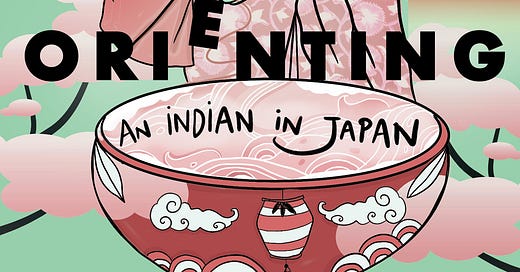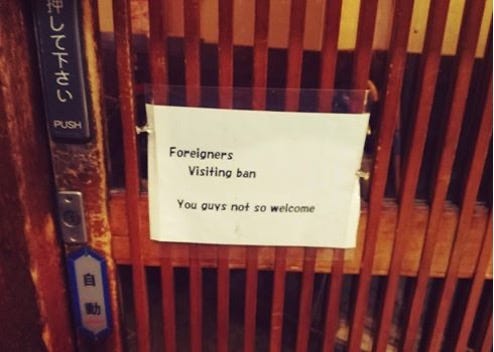Konnichiwa Global Jigsaw,
For this week’s post I am bringing you an extract from chapter 5 of my book, Orienting, that takes a long, hard stare at racism in Japan.
Many Japanese are in denial that anything like racism even exists in their nation, there being a widespread belief that racism is about discrimination by white people against those of colour. As a non-white country Japan is therefore exempt from the need to redress it, or so the argument goes.
In this post I discuss xenophobia, the Japanese far right, the zainichi (Japanese of Korean ethnicity), the Ainu ethnic minority, as well as the Japanese equivalent of India’s untouchables: the burakamin.
If intrigued, please consider buyng the book. Here is the amazon link. It is also available as an audiobook on audible and elsewhere, voiced by me :-)
******
…I had been consistently, and unpleasantly, surprised by the extent to which racism permeated Japanese society in both lazy, careless ways and in more problematic, deep-seated ones.
The former included the infamous “gaijin seat” in trains – the seat next to a foreigner that remained stubbornly empty even on a crowded train, with some Japanese preferring to stand rather than sit next to a gaijin.[1] There was also the phenomenon of foreigners being denied tables at restaurants. Our very first attempt at a meal at a Japanese restaurant on the day after our arrival in Tokyo, had provided front row seats to that particular experience.
We’d wandered past a sliding wooden slatted door with a fluttering noren curtain: the standard signifier of a Japanese restaurant. Excited about whatever gastronomic adventure awaited within, we’d slid the door open and poked our heads inside to be greeted by a flustered looking, kimono-clad woman who had hurtled towards us, arms held up to form a cross- the Japanese symbol for NO. Bewildered at this unexpected rudeness we’d tried, in broken Japanese, to ask for a table, while the lady continued to cross her hands in front of her face and squeezed her eyes shut as though wishing us into vanishing. When she finally opened her eyes and saw us still standing there she spoke slowly, as if to idiots. “NO SUSHI,” she said. “NO TEMPURA.” To her visible dismay we’d shrugged our shoulders and said we’d eat whatever they had to give us.
In the end we were admitted, although were mysteriously denied one of the several empty tables and made to sit at the counter instead. We ate a delicious (and expensive) meal of grilled fish and soup. As the evening wore on the lady in the kimono turned markedly more gracious, pouring sake into our cups with dancer-like elegance. But it had been an unsettling experience.
Over the next few months I learned that it was not all together uncommon for some restaurants, and even some hotels, to deny entry to non-Japanese. I thought this shocking, but when I brought this practice up with a group of Japanese friends they seemed unfazed, their explanations ranging from the inadequate to the appalling. One line of reasoning was that the restaurant staff were afraid about not being able to meet the needs of foreigners since they didn’t speak English. But how did they know that the foreigners couldn’t speak Japanese, I countered? Next, I was told that many foreigners didn’t know how to “behave” in Japanese settings. They might not take off their shoes before entering the tatami mat area, or they might speak loudly on their mobile phones, upsetting the harmony of the occasion for other diners. When this didn’t satisfy me either, I was told consolingly that the practice of keeping foreigners out of certain establishments was not aimed at foreigners “like me,” but at the Chinese.
In a survey carried out by Japan’s Justice Ministry in 2017, nearly a third of foreign residents said that they had experienced derogatory remarks because of their racial background, while about 40 percent had suffered housing discrimination. Among the 4,252 foreigners canvassed, the majority identified as Chinese and Koreans. Over 40 percent had lived in Japan for more than a decade.
One in four job seekers said they were denied employment because of being foreign, and one in five believed they earned less than their Japanese counterparts for similar work. Putting paid to the notion that such discrimination was related to language, 95 percent of foreigners whose job applications were rejected, and over 90 percent of those whose housing applications were denied, were able to speak Japanese “conversationally, professionally or fluently.”
At this point I contacted Debito Arudou, as one did when investigating racism in Japan. The author of Embedded Racism: Japan’s Visible Minorities and Racial Discrimination, Arudou was a very vocal protestor of what he believed to be wide-ranging discriminatory practices in Japanese society. His critics painted him as a bit of a nut case. In a country like Japan his refusal to shut up made him indisputably idiosyncratic.
Originally from the United States, Arudou has lived in Japan since 1991 and took Japanese citizenship in 2000. In 1999 he and his family were refused entry to a public bathhouse in the northern city of Otaru, on the grounds of his being foreign. When his Japanese wife asked whether this exclusion also applied to their daughters who had been born and raised in Japan, the manager said that one daughter who was “Japanese-looking” could enter, but not the other one.
On the phone from an undisclosed location, because he claimed revealing his whereabouts could put him in danger from his many haters, Arudou pinpointed this as the moment that set him down the path of activism. He believed that in some ways visible minorities like himself presented an even easier target of racism than North East Asians. He launched into a lengthy recount of all the times he’d been stopped by the police in Japan and asked to show his identity card. The only reason for this, he claimed, was the practice of racial profiling, common amongst the Japanese police and condoned by many politicians. Arudou pointed out that hugely popular, three-time Tokyo governor, Shintaro Ishihara had told the military in a speech in 2000 that they needed to prepare for the fact that in the event of a natural disaster, foreigners would likely riot and cause civil disorder. Ishihara had also repeatedly blamed Japan’s crime rate on foreigners.[2]
It was a fact that signs stating that certain businesses – spas, hot spring baths, hairdressers, restaurants, brothels - were only open to Japanese clientele were not exceptional in Japan. On Arudou’s blog (http://www.debito.org) examples of exclusionary signs were shared with distressing regularity. When I visited the website, a recent post included the refusal of entry to a golf course to Sapporo Consadole soccer player, Jay Bothroyd, on account of his not being Japanese.[3] There was also write up of a ‘Japanese Only’ sign spotted at a diving and hiking tour company in Okinawa, and another at a bar in Tokyo’s popular Asakusa district.
Taken by a friend in Kyoto
Please subscribe to keep reading





